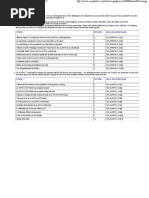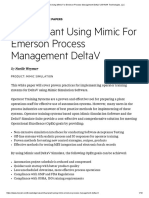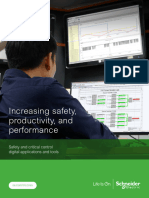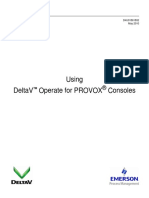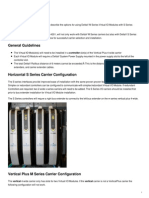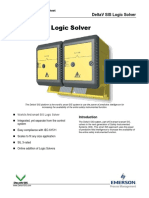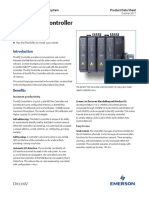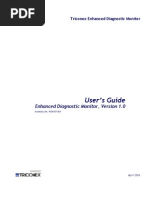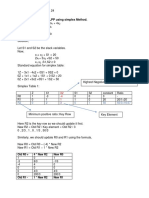EBM White Paper
EBM White Paper
Uploaded by
mcaffeyCopyright:
Available Formats
EBM White Paper
EBM White Paper
Uploaded by
mcaffeyCopyright
Available Formats
Share this document
Did you find this document useful?
Is this content inappropriate?
Copyright:
Available Formats
EBM White Paper
EBM White Paper
Uploaded by
mcaffeyCopyright:
Available Formats
Using the Latest Batch Management Technology to Improve Business Results
Using the Latest Batch Management Technology to Improve Business Results
Table of Contents Introduction ................................................................................................................................................................................3 Common Batch Automation Challenges ..................................................................................................................................3 Batch Automation and S88........................................................................................................................................................3 Batch Control System Architectures ........................................................................................................................................4 Server Based Architecture.......................................................................................................................................................4 Controller Based Architecture..................................................................................................................................................4 Experion Batch Manager Controller Based Architecture..........................................................................................................4 Typical Batch Plant Layout........................................................................................................................................................6 Calculating the Value of a Controller-Based System ..............................................................................................................7 Cycle time Reduction...............................................................................................................................................................7 Improved Availability................................................................................................................................................................7 Ease of Routine Maintenance..................................................................................................................................................8 Reporting and Analysis .............................................................................................................................................................9 Honeywells Solution to Common Batch Challenges............................................................................................................10 Availability..............................................................................................................................................................................10 Modularity ..............................................................................................................................................................................10 Minimum Batch Cycle Times .................................................................................................................................................10 Operator Acceptance.............................................................................................................................................................10 Out of the Box Functionality...................................................................................................................................................10 Flexibility................................................................................................................................................................................11 Cross System Communication ..............................................................................................................................................11 Scalability ..............................................................................................................................................................................11 System Migration ...................................................................................................................................................................11 Delivery & Support Capability .................................................................................................................................................11 Summary ...................................................................................................................................................................................12
Using the Latest Batch Management Technology to Improve Business Results
Introduction
Todays competitive environment demands automation solutions that increase plant efficiency and profitability. Control system performance can significantly impact a plants bottom line. Leveraging automation capabilities through simplified, cost-effective new technology while optimizing current investments is key to success. As technology advances, legacy batch control systems can no longer meet corporate objectives that include production agility, production reliability, reporting and sharing of business information. Nor can they provide sophisticated control capabilities that enable increased throughput, lower costs and improve regulatory compliance while responding to customer demands for better product quality and faster delivery cycles. This paper considers typical requirements for safe and manageable batch control systems, and provides guidance for users who seek the latest process automation technology while making the most of existing plant assets and intellectual property. The solutions discussed show how Honeywells Experion Batch Manager, the first batch management system to utilize this latest control system technology, can improve production and business results.
Common Batch Automation Challenges
Most batch plants face common challenges which include: Maximizing productivity from assets in use to meet demand Producing an increasing number of different products Maintaining the complex sequencing software in batch execution often on mature control platforms Reducing production costs to remain competitive Technology now available for batch automation can help with these challenges to improve business results.
Batch Automation and S88
The ISA S88 standard for batch processes has been in use for some years and has provided significant measurable benefits for all stakeholders in the batch industry. S88 has provided a common structure and vocabulary which has been universally adopted and enables end users and vendors to adopt the same terminology which is immediately understood.
Using the Latest Batch Management Technology to Improve Business Results
Batch Control System Architectures
Server Based Architecture
The first generation of S88 batch control systems rely on parts of the batch executing in a server or other high level network node. This server becomes a communication bottleneck between the controllers which carry out the process actions and the operator. In server based architectures the operators view of the batch is provided via the batch server and server failure can lead to loss of view and loss of production. Control of phases is also reliant on the server. A server failure can lead to a hazardous situation or reduction in quality if phases cannot execute as configured when expected. While a batch server can be nominally redundant manual intervention is still required to change over between servers. Batch processes require many peer to peer connections between controllers, a function that cannot be performed by the batch server. Peer to peer configuration is engineering intensive and complex to maintain. The server is a Microsoft machine and so periodically an interruption to production is required for it to be shut down for routine maintenance.
Controller Based Architecture
Progress in technology now allows an entire batch sequence to execute in the controller which brings a number of business benefits over the server based batch system. A controller based system is inherently more robust and provides a single operating and engineering platform for batch execution. The absence of a server removes the associated costs, security and maintenance issues as well as communication latency.
Using the Latest Batch Management Technology to Improve Business Results
Experion Batch Manager Controller Based Architecture
Experion Batch Manager overcomes these problems by providing a single controller platform on which all levels of the S88 procedural model execute. This controller can be optionally redundant using a well proven bumpless changeover mechanism. The operators view of the batch comes directly from the redundant controller and is not dependent on a batch server or on any single point of failure. Multiple Experion controllers behave as a single virtual controller. As all batch functions are built into the system, there is no additional batch hardware or software package to purchase, install and maintain. Standard displays are provided for all batch functions and can be augmented with custom displays showing batch information in the context of familiar plant layouts. A batch system may consist of up to 20 redundant controllers with no configuration effort for peer to peer connections. A C300 can be migrated between releases on process and does not require shutdown for any change to batch or other control configuration. Removing the communication bottleneck of the batch server reduces batch cycle times. Transition from one phase to the next no longer involves a server and may take place in the same controller. This reduces communication dead time during phase transitions.
Using the Latest Batch Management Technology to Improve Business Results
Typical Batch Plant Layout
A number of challenges to improving batch production are considered with reference to this model plant. This diagram shows a typical small batch plant consisting of a pre mixer, two reactors and two blenders with a number of raw materials and a flexible path through the plant. For the purposes of this paper, the number of different product which can be produced in this plant is 22.
Valid paths through the plant are: Pre Mixer > Reactor 1 > Blender 1 Pre Mixer > Reactor 1 > Blender 2 Pre Mixer > Reactor 2 > Blender 1 Pre Mixer > Reactor 2 > Blender 1 This plant can produce 22 different products. The batch system supports any valid route through the plant from a single recipe. This keeps maintenance of the recipes at a manageable level. A recipe can be considered as being in two parts: first, the procedural element of Procedure/Unit Procedure/Operation and second, the formula values (times, temperatures and raw material quantities). The procedural elements may differ little between products. For example, if Material 4 is not used in product 14 but is used in all others, then a formula value of 0 is entered and the Material 4 phase does not execute when product 14 is being produced. The same procedure may therefore be used for multiple products. For the purposes of this example, assume products 1 to 18 require procedure A and products 19-22 required procedure B. All products can be accommodated by building and maintaining 2 procedures and 22 formula sets. The procedure, formula and route through the plant are selected at run time. Equipment can be selected at any point during recipe execution before the unit procedure requiring that equipment executes. The plant includes shared equipment which must be acquired and released by a batch. For example if Material 4 is being delivered to B1 and R2 reaches a point in the batch where Material 4 is required, the request from R2 for Material 4 is queued. If B2 also requires Material 4 before the addition to B1 is complete, this request is also queued. The requestors are allocated the requested resource on a first-in first-out basis. Any equipment element, not necessarily an equipment module, can be declared as a shared resource. For example, only certain concurrent reactor discharge routes are valid. R1 to B1 concurrent with R2 to B2 are valid but not R1 to B2 concurrent with R2 to B1. The horizontal line between R1 and R2 is effectively a shared item of equipment and can be tagged and declared as such. If R1 is discharging to B2, the shared pipe must be acquired. If R2 reaches a discharge point to B1, the batch requests the pipe and queues until it is released by R1.
Using the Latest Batch Management Technology to Improve Business Results
Calculating the Value of a Controller-Based System
Cycle Time Reduction
Taking into account factors such as the sales value of the product and market conditions, the execution of a batch in the controller impacts business results. The dead time for communication exchange between a server and controller reduces the throughput of a plant. In the example let us assume that: Additional production can be sold profitably Sale value of a batch is $3000/ton Finished batch = 2 tons of saleable product Reactor is the plant bottleneck Average batch cycle time = 6 hours for reactor and blender Plant operating days per year = 340 at 24 hours per day Batches per year = ((340 x 24)/6) x 2) = 2720 batches Number of recipe steps = 70 By moving batch execution from a server to the controller: Honeywells Batch Manager reduces step delay times from 12 seconds to 2 seconds Reduced batch cycle time to 5 hrs 48 mins (70 x 10 seconds) Batches per year = ((340 x 24)/5.8) x 2 = 2814 batches (3% increase) 94 additional batches per year = addition revenue of $564K Customer experience is that the flexibility of Experion Batch Manager enables many other improvements in batch cycle time, raw material usage and user productivity.
Improved Availability
Using the Latest Batch Management Technology to Improve Business Results
The availability of a batch plant which stops and starts every few hours is often not scrutinized in the same way as that of a continuous plant which has long startup times. Failure of a batch system can result in business disruption, not just in failure to produce salable product. In the model, plant Material 2 has a short storage life and is part of the production of an upstream plant which runs continuously. Only 6 hours of storage capacity is available for Material 2. The impact of an 8 hour outage due to a batch server failure could result in:
Financial impact
Lost product with a sales value of 8 batches Cost of shutting down upstream plant which produces other products Disposal of off spec production from incomplete batches Total $48K $90K $ 5K $143K
Non financial impact
Safety or environmental incidents from unexpected process disruption Disruption to customer deliveries Execution of complete batches using Experion Batch Manager takes place on a platform with no single point of failure. Interruptions due to hardware failures can therefore always be avoided.
Ease of Routine Maintenance
All batch systems require regular changes, for example to accommodate modifications to equipment, changes in product specification or process improvements. Experion Batch Manager requires no shutdown of any element to make any type of change. Equipment and recipe configuration can be changed online, controllers or other hardware additions take place online. Even software migration can take place on process. First generation server-based batch systems required a shutdown of the server and/or controller for plant configuration changes, network configuration changes and Microsoft patch installation. This may only be possible during a schedule window when there are no batches running in the plant. With batch processes involving long residence times, this may occur only once per year or in any process only with extensive planning and a period of reduced production. As a result, improvements and important changes get delayed until a planned server shutdown window. With Experion Batch Manager, changes can be made at any time online without any interruption to production. By building batch into the system, Batch Manager reduces the skill level required to support these routine changes. The same engineering tools and user environments handle all DCS configuration and maintenance functions. This means that appropriately skilled DCS engineers can maintain the whole system. In contrast, first generation batch systems involve add-on software packages requiring specialist skills and training in addition to support of the server itself. They are maintained in a different engineering and operating environment which reduces user acceptance. Typical annual savings for the sample plant are: Reduced support costs for server and batch application Reduced training costs Benefits from timely process improvements vs. waiting for shutdown window Lost production avoided through on-line changes vs. planned shutdown Total annual savings Experion Batch Manager can reduce support and maintenance costs by building batch functions into the system. $25K $10K $30K $90K $155K
Using the Latest Batch Management Technology to Improve Business Results
Reporting and Analysis
The chemistry of a batch process for a specific product is often less understood than for well developed continuous processes. Careful attention may be paid to creating and checking recipes, but closing this loop by analyzing what happened in a batch or series of batches rarely occurs. Gathering historical data on batches and providing tools to convert the data into actionable information is an enabler for a range of process improvement activities around quality, consistency, yield improvement, safety and environment. First generation batch systems provided batch reports at the end of a batch as a text file or printed report. This meets basic reporting requirements on what occurred during a specific batch, but management of paper or file-based reports is inefficient. All the data of interest is usually stored in a database or process historian, but bringing it together electronically is a data management challenge. In the model plant, a user may want to investigate a quality problem with a batch produced 4 weeks ago with which quality problems have been reported. He suspects a crystallization problem in the cooling phase but his only reference point is the batch identifier. To manually view data on the batch he needs to know: Which reactor did the batch run in? What date/time did the batch start and finish? What are the tag names for temperature and pressure on the reactor? To find this information he has to search through multiple sets of records but can then view a batch report and configure a trend of pressure and temperature for the batch. Experion Batch Manager used in conjunction with Honeywells reporting product, Procedure Analyst, automates this process using the batch identifier as the only reference. The first step would be to review a batch report showing data relevant to that batch. If this appears in order, a user can select the batch identifier and display a preconfigured trend for that batch. Procedure Analyst also uses the concept of a Golden Batch known to be on spec with which other batch trends may be displayed on the same axis for analysis. This batch trend shows the batch of interest (red) trended with other batches, and a difference in cooling profile can be seen. Having identified that this may be the source of the quality problem, the user can then quickly configure a batch query which interrogates all the batch and continuous data for batches where the cooling time has been as long as the batch of interest on which he can view reports and trends. He may find that other batches with long cooling times exhibited similar quality problems and initiate some process improvement activities. Experion Batch Manager in conjunction with Procedure Analyst provides data and associated tools to help improve the efficiency of processes.
Crystallization problem due to slow cooling?
Using the Latest Batch Management Technology to Improve Business Results
10
Honeywells Solution to Common Batch Challenges
Availability
My process really needs a fully redundant platform to execute batches. Material 3 must be added to R1 or R2 as soon as conditions of temperature and pressure are reached. If a batch stops mid-execution, the process consequences can be hazardous or equipment can be damaged. Server based batch platforms do not give the level of redundancy I need. Batch Manager runs on a fully redundant controller and requires no other hardware to be available for phase transitions to take place.
Modularity
I see the benefits of S88, but I do need to execute parts of a recipe in some circumstances and not the whole recipe. The batch system I have today only executes complete recipes so if the operator wants to wash out a blender he has to run a complete recipe. An operator can manually operate any element on the S88 hierarchy. In this example he can run a water addition phase, fill the blender, start then stop the agitator manually and run a discharge phase when complete.
Minimum Batch Cycle Times
My plant is fully sold at present so I am looking to reduce batch cycle times. I notice some really long dead time between consecutive batch steps. I would like to reduce those times to reduce my batch cycle time. The communication dead time between server and controllers can result in two minutes of dead time between one phase completing and the next starting. This is unproductive time for the plant. Experion Batch Manager runs in the much faster environment of the controller and this time can be reduced to six seconds. Reducing this time alone can translate into increased throughput of up to 2%.
Operator Acceptance
Display ergonomics improve our operators performance. They want to see batch information as part of a process display and to navigate away as little as possible. Batch Manager comes with a toolkit of display objects that can be embedded in customer displays to show the operator what is happening to a batch in the context of familiar plant representation without navigating away to another display. Navigation to more detailed information is achieved with a minimum number of clicks.
Out of the Box Functionality
Having a batch package added on to our DCS has cost more than we would like. There is additional training, support and expertise required. I want to see the batch functions built into the system and available out of the box. Honeywell has embedded all Batch Manager functionality in the controller. There is no additional software package or hardware to purchase and learn about. Batch configuration and user interface is based on the same visual conventions and uses the same tools as the rest of Experion. As a result, operators and other personnel experienced with Experion find the batch functions straightforward and intuitive to use.
Using the Latest Batch Management Technology to Improve Business Results
11
Flexibility
Expectations from our customers and our own process chemists are that our batch plant produces a wider range of products in smaller quantities than we have in the past. To do this, the number of routine changes we have to make to our system is increasing. We want any changes to be made quickly without the need for a window of equipment downtime. This reflects a challenge in flexibility seen across the chemicals industry. As with the rest of Experion, all changes to batch configuration can take place online without impacting production no exceptions. Batch equipment configuration can be changed on process. Any hardware addition or removal including a complete controller can be achieved on process. Even a software release migration can be carried out with batches running.
Cross System Communication
We have a large batch system and need controller level connections from any part of the plant to any part of the plant. With our current system, this involves a lot of setup particularly for shared material feeds and has to be thought about very carefully if we change anything. Making this easier would reduce our costs. All controllers configured in an Experion server behave as a single virtual controller. The engineer, formulator or operator requires no knowledge of where any one element executes. Peer to peer communication between controllers is transparent to all users. This reduces the engineering effort to design and configure a batch system, can reduce the hardware cost and makes routine changes easier and quicker to implement.
Scalability
We are building a new plant for a new product. If the product is successful we will expand it with additional units and increase the level of automation. In the past, this has involved moving I/O connections, moving blocks of code and a large reconfiguration and compiling activity. We do not want a costly, risky and disruptive modification like this to do when we expand. With an Experion server behaving as a single virtual controller, expansion is easy. Controllers and I/O can be added online with no disruption to the process. If it becomes necessary to move things around, this is simply an export and import without cutting and pasting of code. This enables an expanded plant to run sooner and cuts the cost of that expansion.
System Migration
Our batch system is 15 years old and becoming very expensive to maintain. We have looked at replacing it but are concerned about the risk of re-engineering and disruption to production of such a large project. If the system is from Honeywell, there will be a migration path to todays technology designed to protect your investment and minimize the cost, risk and disruption of a migration. Many migrations can be achieved with no hardware modifications.
Delivery & Support Capability
Manufacturers who select Batch Manager have plenty of choice in how they deploy the solution. In the project phase, some choose to use their own resources with training and support from Honeywell personnel. Others choose to give Honeywell responsibility for the design and implementation. Honeywell has several engineering centers with the skills needed for implementation of batch systems. In addition to batch skills, this strategy enables manufacturers to gain benefits from the rest of the project delivery infrastructure such as hardware build, installation and commissioning. During the lifetime of the system, Honeywells service organization has a wide range of support offerings from basic callout response to maintenance contracts where routine maintenance and minor changes are carried out by Honeywell. Technology will change during the life of a system, and lifecycle management services ensure that hardware and software is kept up to date. Experion Batch Manager users are backed up by a strong project and service organization to maximize the controller-based system benefits and to keep them at that level.
Using the Latest Batch Management Technology to Improve Business Results
12
Summary
Controller based architecture uses current technology to overcome problems experienced with batch solutions from the past by building batch into the system. Honeywells Experion Batch Manager is designed to maximize the availability, productivity, operability and maintainability of any batch plant to improve efficiency and profitability. It can be deployed and maintained with the support of Honeywells impressive project and service organization.
For More Information For more information about Honeywell Experion Batch Manager, visit www.honeywell.com/ps or contact your Honeywell account manager. Automation & Control Solutions Process Solutions Honeywell 1860 W. Rose Garden Lane Phoenix, AZ 85027 Tel: 800-822-7673 www.honeywell.com/ps
WP-10-05-ENG May 2010 2010 Honeywell International Inc.
You might also like
- AP-0800-0154 - DeltaV Safety Instrumented Systems (SIS) Software UpdatesDocument21 pagesAP-0800-0154 - DeltaV Safety Instrumented Systems (SIS) Software Updatesanggit994100% (1)
- Problem StatementDocument17 pagesProblem Statementgowtham100% (1)
- DeltaV SIS Module - Level ParametersDocument1 pageDeltaV SIS Module - Level ParametersmacconnorNo ratings yet
- Modeling Bubbling Fluidized Bed Using DDPM+DEMDocument11 pagesModeling Bubbling Fluidized Bed Using DDPM+DEMVasanth Aradhya100% (1)
- Aspen DMCplus Online ToolsDocument2 pagesAspen DMCplus Online Toolspartho143No ratings yet
- Product Data Sheet Deltav SQ Controller en 57724Document6 pagesProduct Data Sheet Deltav SQ Controller en 57724samim_khNo ratings yet
- EXP 02 Experion PKS Fundamentals Server Engineering and Configuration ImplementationDocument1 pageEXP 02 Experion PKS Fundamentals Server Engineering and Configuration Implementationkhaledessahli9No ratings yet
- HIMA HIQUAD SystemsDocument3 pagesHIMA HIQUAD Systemssina20795No ratings yet
- DeltaV Plant WebDocument3 pagesDeltaV Plant WebRonald Paucara CallasiNo ratings yet
- WWTP Sequence Programming - Proof of Concept - Draft OnlyDocument10 pagesWWTP Sequence Programming - Proof of Concept - Draft Onlyjose velardeNo ratings yet
- s71200 System Manual en-US en-US PDFDocument1,328 pagess71200 System Manual en-US en-US PDFVanessa Soria100% (1)
- PWS 008289Document12 pagesPWS 008289Hanan KhanNo ratings yet
- 07-Advanced Control ProductsDocument137 pages07-Advanced Control ProductsakramhomriNo ratings yet
- 01 - 04R201 - 1 - CEE Controller ArchitectureDocument54 pages01 - 04R201 - 1 - CEE Controller ArchitectureFathima MinishaNo ratings yet
- CCP150 Studio 5000Document2 pagesCCP150 Studio 5000Jonathan OttoNo ratings yet
- As IEC 61131.2-2004 Programmable Controllers Equipment Requirements and TestsDocument14 pagesAs IEC 61131.2-2004 Programmable Controllers Equipment Requirements and TestsSAI Global - APACNo ratings yet
- AMS User GuideDocument92 pagesAMS User GuidesanitamaNo ratings yet
- FactoryTalk Batch View HMI Controls - Quick StartDocument28 pagesFactoryTalk Batch View HMI Controls - Quick StartVÕ QUỐC HIỆUNo ratings yet
- SQLplusDocument428 pagesSQLplusYury BeloglazovNo ratings yet
- Virtual Plant Using Mimic For Emerson Process Management DeltaVDocument19 pagesVirtual Plant Using Mimic For Emerson Process Management DeltaVYusufNo ratings yet
- Steps To Install SQL Server 2022 On Windows Operating Systems To Log FactoryTalk Alarms and EventsDocument18 pagesSteps To Install SQL Server 2022 On Windows Operating Systems To Log FactoryTalk Alarms and EventsSharad AdelkarNo ratings yet
- Experion LCN Tech Spec PDFDocument27 pagesExperion LCN Tech Spec PDFjashkishoreNo ratings yet
- Centum Cs 1000 r3Document11 pagesCentum Cs 1000 r3sina20795No ratings yet
- 998-22735626 - Software Tools - GMA - BrochureDocument20 pages998-22735626 - Software Tools - GMA - Brochureabderraoufdob2No ratings yet
- FactoryTalk View SE Network Station Architecture ConsiderationsDocument6 pagesFactoryTalk View SE Network Station Architecture Considerations1meander23No ratings yet
- FactoryTalk View ME To FactoryTalk View SE Conversion - Reproduce Some of The Common FactoryTalk View ME FunctionalityDocument10 pagesFactoryTalk View ME To FactoryTalk View SE Conversion - Reproduce Some of The Common FactoryTalk View ME FunctionalityOnkar Narendra AphaleNo ratings yet
- SFC Introduction Guide R149-E1-01Document60 pagesSFC Introduction Guide R149-E1-01sukaryadi1No ratings yet
- DVOP User ManualDocument210 pagesDVOP User ManualJim HerwigNo ratings yet
- World's First Truly Integrated Safety Controller: Safe, Reliable and Available Control Without CompromiseDocument6 pagesWorld's First Truly Integrated Safety Controller: Safe, Reliable and Available Control Without CompromiseDinesh JadavNo ratings yet
- Mkted2140504en Esx Control ExpertDocument50 pagesMkted2140504en Esx Control Expertalexns84No ratings yet
- Double-Stream Mill & Silo Monitoring Instruction Manual (MSM-100-D) Đo CO Phân LyDocument50 pagesDouble-Stream Mill & Silo Monitoring Instruction Manual (MSM-100-D) Đo CO Phân Lynguyễn hữu trườngNo ratings yet
- PDS BatchExecutiveDocument5 pagesPDS BatchExecutiveMark CaffeyNo ratings yet
- Using DeltaV M Series Virtual IO Modules With S Series ControllersDocument3 pagesUsing DeltaV M Series Virtual IO Modules With S Series ControllersCarlos AlbertoNo ratings yet
- Deltav Sis Logic Solver (2013) PDFDocument14 pagesDeltav Sis Logic Solver (2013) PDFmgkvprNo ratings yet
- PlantPAx HMI Security ConfigurationDocument1 pagePlantPAx HMI Security ConfigurationjaysonlkhNo ratings yet
- WW TSS-04 Advanced Troubleshooting For Wonderware Application ServerDocument79 pagesWW TSS-04 Advanced Troubleshooting For Wonderware Application ServerJunio AmorimNo ratings yet
- Dokumen - Tips - Deltav Sis Standalone Deltav Documentsdeltav Sis Process Safety System WhitepaperDocument13 pagesDokumen - Tips - Deltav Sis Standalone Deltav Documentsdeltav Sis Process Safety System WhitepaperIkhtiander IkhtianderNo ratings yet
- Product Data Sheet Deltav MQ Controller en 57688Document5 pagesProduct Data Sheet Deltav MQ Controller en 57688faisal84inNo ratings yet
- Foundation Fieldbus: EMERSON Process Management Educational ServicesDocument44 pagesFoundation Fieldbus: EMERSON Process Management Educational Servicesjose luis cordova arnezNo ratings yet
- S-Series Interface For PROVOX IODocument44 pagesS-Series Interface For PROVOX IOSaad BroNo ratings yet
- Opc Dotnet 3 0 Simplifies Client Access To DeltavDocument35 pagesOpc Dotnet 3 0 Simplifies Client Access To DeltavDmitry SolovovNo ratings yet
- Experion CEE-based Controllers and I/O: Doc EP03-290-400Document43 pagesExperion CEE-based Controllers and I/O: Doc EP03-290-400MesratNo ratings yet
- APC-4500VE SECCION 6.2. Guia de Usuario Profit Suite Visualization User GuideDocument476 pagesAPC-4500VE SECCION 6.2. Guia de Usuario Profit Suite Visualization User GuideNorberto PeñaNo ratings yet
- In STEP 7 (TIA Portal) V11, How Can You Upload Blocks From The CPU To The PGDocument4 pagesIn STEP 7 (TIA Portal) V11, How Can You Upload Blocks From The CPU To The PGAndrew Dela CruzNo ratings yet
- DCS Graphics STD (Rev 2 0)Document52 pagesDCS Graphics STD (Rev 2 0)Luke FieldingNo ratings yet
- ESD Ovation SystemDocument7 pagesESD Ovation SystemMuhammadIkhsanRestiadiNo ratings yet
- Emerson Exchange 365 - 5Document8 pagesEmerson Exchange 365 - 5jns1606No ratings yet
- Delta VDocument50 pagesDelta VariekarpfNo ratings yet
- Basic Script Users Guide EP-DSX756Document118 pagesBasic Script Users Guide EP-DSX756akramhomriNo ratings yet
- Høgskolen I Telemark: Bachelor I IngeniørfagDocument30 pagesHøgskolen I Telemark: Bachelor I IngeniørfagAnonymous bvuCxCnQ9No ratings yet
- Allen Bradley InterfaceDocument10 pagesAllen Bradley Interfacemsalem73100% (1)
- 9ARD171385-510 en AC 800M 5.1 IEC 61850 ConfigurationDocument130 pages9ARD171385-510 en AC 800M 5.1 IEC 61850 Configurationrodrigo_belchiorNo ratings yet
- Advanced Continuous HistorianDocument7 pagesAdvanced Continuous HistorianisraelalmaguerNo ratings yet
- Yokogawa Job VacancyDocument4 pagesYokogawa Job Vacancy鲁肃津No ratings yet
- The Digital Mine:: How To Implement Predictive MaintenanceDocument6 pagesThe Digital Mine:: How To Implement Predictive MaintenanceM A GallegosNo ratings yet
- Triconex Enhanced Diagnostic MonitorDocument114 pagesTriconex Enhanced Diagnostic Monitorchski21100% (1)
- Certified Automation Professional A Complete Guide - 2020 EditionFrom EverandCertified Automation Professional A Complete Guide - 2020 EditionNo ratings yet
- Certified Functional Safety Expert A Complete Guide - 2020 EditionFrom EverandCertified Functional Safety Expert A Complete Guide - 2020 EditionNo ratings yet
- AMOS ShortcutsDocument2 pagesAMOS ShortcutsAnjit RajkarnikarNo ratings yet
- Lebanese International University: CSCI 250 - Introduction To Programming Quiz-2 Student Name: Student IDDocument4 pagesLebanese International University: CSCI 250 - Introduction To Programming Quiz-2 Student Name: Student IDralf tamerNo ratings yet
- TUP650 2018 EN Electron.Document4 pagesTUP650 2018 EN Electron.Khhg AgddsNo ratings yet
- Engagement LetterDocument2 pagesEngagement LetterOmobolanle OlagunjuNo ratings yet
- Realhowto JavaDocument756 pagesRealhowto JavaandrastyleNo ratings yet
- Cs 603Document18 pagesCs 603kunarajeet17No ratings yet
- Talend Quick BookDocument38 pagesTalend Quick Bookkailash yadavNo ratings yet
- Cyber Law Question PaperDocument5 pagesCyber Law Question Papersudarshan_lokhande4598100% (2)
- Understanding The Dynamic Mho Distance Characteristic: Donald D. Fentie, Schweitzer Engineering Laboratories, IncDocument15 pagesUnderstanding The Dynamic Mho Distance Characteristic: Donald D. Fentie, Schweitzer Engineering Laboratories, IncAdriano de CarvalhoNo ratings yet
- MATLAB Command WindowDocument9 pagesMATLAB Command WindowYasser MelizouNo ratings yet
- Resume ModelDocument3 pagesResume Modelvignesh ajeedhNo ratings yet
- Building Multi Tenant Applications With DjangoDocument53 pagesBuilding Multi Tenant Applications With DjangoDavidson Caetano100% (1)
- Intelligent Metal Detector1Document19 pagesIntelligent Metal Detector1dinesh j100% (1)
- IAS General Studies NotesDocument7 pagesIAS General Studies NotesVishal_M53No ratings yet
- Iatf 16949 Reference Process (Map) Document Name Notes: Bms@Gdrive FolderDocument6 pagesIatf 16949 Reference Process (Map) Document Name Notes: Bms@Gdrive FolderVikas KunduNo ratings yet
- Prashant Joshi 29 It Summertraining PDFDocument47 pagesPrashant Joshi 29 It Summertraining PDFPrashantJoshiNo ratings yet
- Datasheet Electromagnetic Transmitter 5000 6000Document12 pagesDatasheet Electromagnetic Transmitter 5000 6000Joko SchumacherNo ratings yet
- Nabimara Charles Cit PGD ReportDocument56 pagesNabimara Charles Cit PGD ReportArsalan FarooqNo ratings yet
- Cisco ONS 15305Document208 pagesCisco ONS 15305Henrynho25No ratings yet
- Nexus PDFDocument11 pagesNexus PDFNazeer AbdulrahmanNo ratings yet
- Project Management Techniques: Steve SnellingDocument57 pagesProject Management Techniques: Steve SnellingTubagus Donny SyafardanNo ratings yet
- Facility Location Model: A Case Study: Miguel Limão BergerDocument10 pagesFacility Location Model: A Case Study: Miguel Limão BergerMainak SarkarNo ratings yet
- Anurag - Hacking With ExpertsDocument128 pagesAnurag - Hacking With ExpertsRavi Chandra Medisetty100% (3)
- Klineberg Dying Alone 2001Document32 pagesKlineberg Dying Alone 2001ralaghiNo ratings yet
- NAG-IBA I.decDocument26 pagesNAG-IBA I.decAngelika CalingasanNo ratings yet
- What Is The Jamstack - JamstackDocument4 pagesWhat Is The Jamstack - Jamstackpaul.zimba96No ratings yet
- Lab 2: Introduction To Assembly Language ProgrammingDocument9 pagesLab 2: Introduction To Assembly Language Programmingdarwinvargas2011100% (1)
- Solution of TutorialDocument20 pagesSolution of TutorialPrabin GcNo ratings yet


